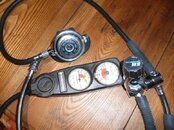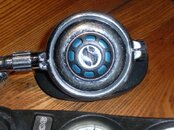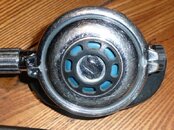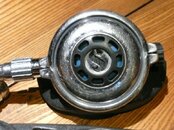ReneB
Registered
A friend's husband is no longer diving and has offered us some of his gear. As a newly certified diver, please forgive my ignorance if I am not using all the correct terms, ok  .
.
I'm looking for some help to ID this equipment but mostly to see if it's worth servicing and using. The person who's selling the equipment is someone that generally takes good care of his stuff, we were told that when it was all put away (about 2-3 years ago) all was working well.
I think this is a MK 10 Regulator and an unknown 2nd stage (could it possibly be a version of the R109?). If there is anything else in the pictures you can help me ID, please feel free!
I'd like to know, please, is the 2nd stage worthy of servicing? I gathered from poking around on this forum a bit that the MK10 is definitely worthy, but I have no idea re. the 2nd stage.
Just to give some background, my son and I are newly certified, and to date all of our skin and scuba diving have been done in warm tropical and subtropical waters. However, we live in the Fingerlakes region of NY and are very interested in exploring them. We know that there are some wrecks at a nearby lake (Seneca) and the Erie Canal system throughout the other lakes in the region also have some features worth exploring. That means that perhaps we'd need this regulator/2nd stage to work in colder waters too.
Thanks in advance for your help folks!
I'm looking for some help to ID this equipment but mostly to see if it's worth servicing and using. The person who's selling the equipment is someone that generally takes good care of his stuff, we were told that when it was all put away (about 2-3 years ago) all was working well.
I think this is a MK 10 Regulator and an unknown 2nd stage (could it possibly be a version of the R109?). If there is anything else in the pictures you can help me ID, please feel free!
I'd like to know, please, is the 2nd stage worthy of servicing? I gathered from poking around on this forum a bit that the MK10 is definitely worthy, but I have no idea re. the 2nd stage.
Just to give some background, my son and I are newly certified, and to date all of our skin and scuba diving have been done in warm tropical and subtropical waters. However, we live in the Fingerlakes region of NY and are very interested in exploring them. We know that there are some wrecks at a nearby lake (Seneca) and the Erie Canal system throughout the other lakes in the region also have some features worth exploring. That means that perhaps we'd need this regulator/2nd stage to work in colder waters too.
Thanks in advance for your help folks!







